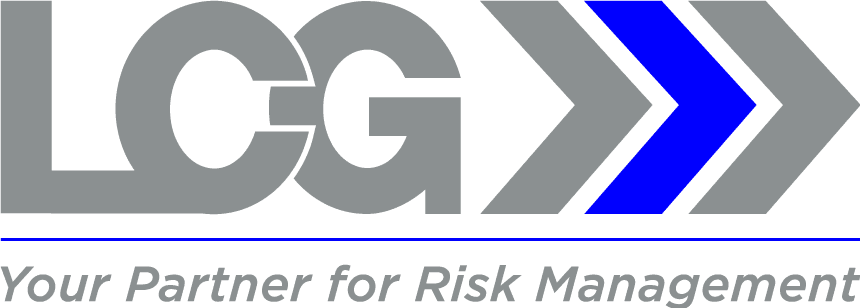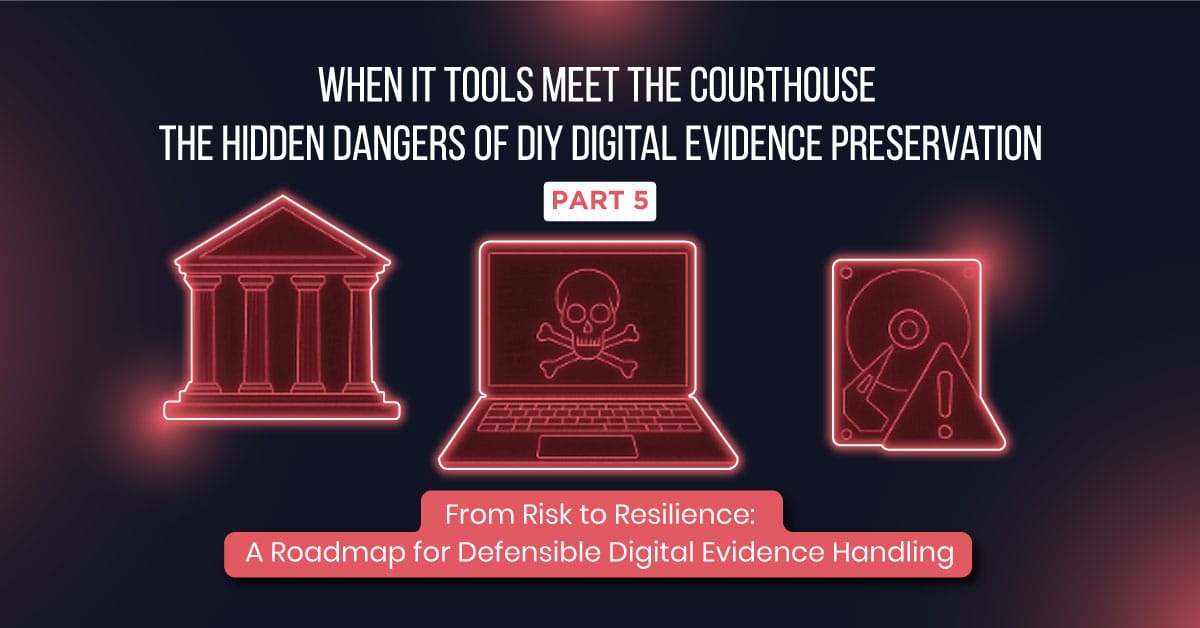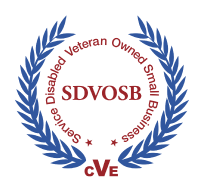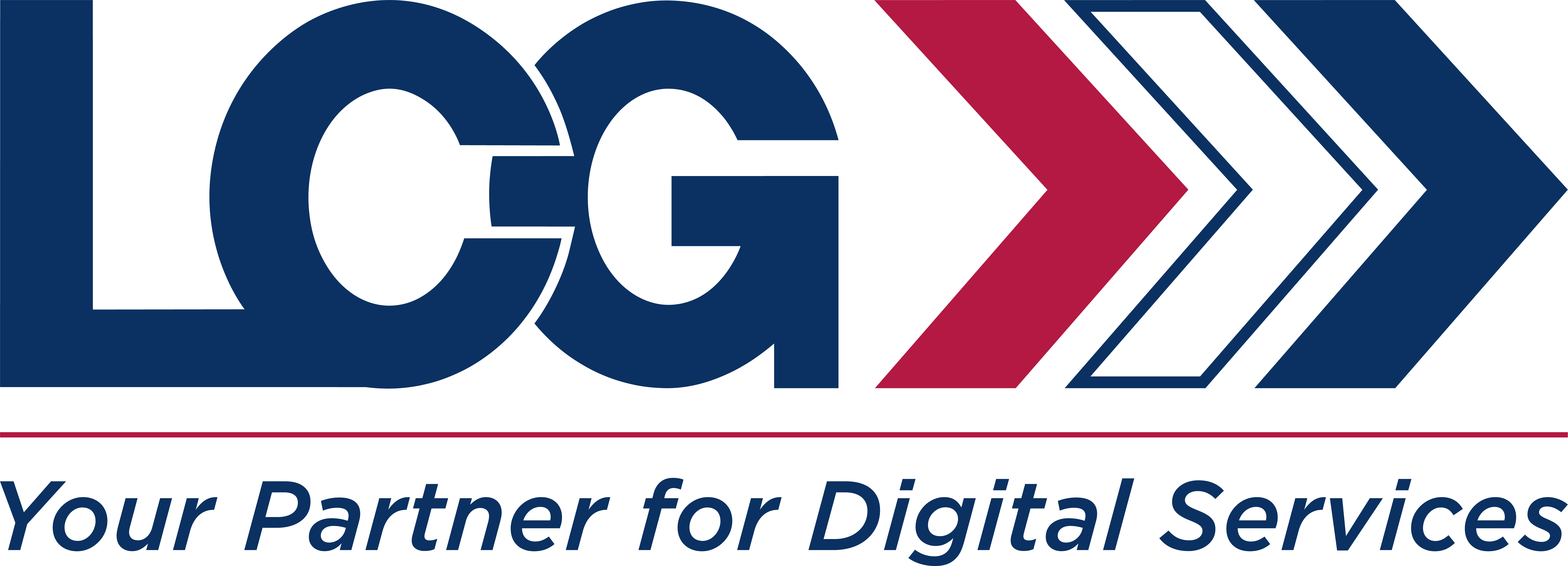Part 5 – From Risk to Resilience: A Roadmap for Defensible Digital Evidence Handling
Contributed by Kris Carlson, COO, Former ICAC Commander, and Digital Forensics Investigator/Testifying Expert
Introduction
In the first four installments of “When IT Tools Meet the Courthouse: The Hidden Dangers of DIY Digital Evidence Preservation,” we uncovered a sobering truth: when IT teams or other non-forensically trained/experienced personnel collect evidence using consumer-grade tools and ad-hoc processes, the courtroom becomes a minefield. Bad hashes (or no hash value validation at all), overwritten logs, incomplete exports, and overconfident administrators routinely hand opposing counsel the ammunition to call collections and data into question, at best, and are likely facing spoliation motions and Daubert challenges.
In this final article, we pivot from autopsy to action. What does a solidly defensible, litigation-ready preservation program look like in 2025? How do corporate legal, cybersecurity, and operations leaders transform “good-enough” backups into forensically defensible evidence flows, without blowing up budgets or business agility? The roadmap that follows weaves together international standards, such as ISO/IEC 27037, the Sedona Principles, emerging Rule 37(e) case law, and real-world cost data to provide a pragmatic blueprint for transitioning from risk to resilience.
Governance Frameworks: Anchoring Policy in Recognized Standards
A defensible program begins with governance, and governance begins with language that everyone, including GCs, CISOs, auditors, and judges, can accept. ISO/IEC 27037:2012 (reaffirmed in 2024) provides this framework by codifying the primary pillars of this process: Identification, collection, acquisition, and preservation, and outlining verifiable controls such as hashing, write-blocking, and logging (webstore.ansi.org).
For U.S. litigation, the Sedona Principles remain the de facto playbook for proportionality, scope, and cooperation. Principle 2’s focus on proportionality mandates that courts balance “cost, burden, and need,” resonating with corporate stakeholders wrestling with terabytes of data and limited budgets. Principle 10’s call to protect privilege and privacy dovetails with modern data-protection statutes, while Principle 14 explicitly recognizes remedial measures, sanctions (or both) as a remedy when preservation duties are breached (paed.uscourts.gov).
These frameworks serve as the foundation for the defensible and successful preservation and production of data. Companies would be wise to incorporate both documents into their working policies. Incident response plans can cross-reference ISO 27037 and the corresponding Sedona principles. When regulators or opposing counsel ask, “Why this method?” counsel can point to globally recognized standards, as opposed to rationalizations required to justify DIY collections.
DIY vs Third-Party Decision Matrix
Even the best policy cannot eliminate the perennial dilemma: should IT collect in-house or bring in certified examiners? Rather than a binary rule, mature organizations employ a decision matrix weighted on five criteria:
| Factor | Low-Risk Indicator (DIY may be OK) | High-Risk Indicator (Engage Experts) |
| Data Sensitivity | Public or non-PII content | Trade secrets, PHI, CUI |
| Volume & Diversity | ≤ 50 GB, single platform | Multi-cloud, mobile, IoT logs |
| Regulatory Stakes | No sector-specific mandates | HIPAA, DFARS, GDPR, SEC |
| Dispute Horizon | Internal HR inquiry | Anticipated civil/criminal action |
| Skill Availability | Forensically certified staff on payroll | Admins without forensic certs |
Apply thresholds quantitatively. If a matter scores three or more “High-Risk” flags, it may be best to outsource. Caution should be taken, however, as even low-risk scenarios can quickly morph into large-scale collections across multiple platforms. If the foundation of that subsequent collection or relevant evidence were derived from internal resources, issues would arise. Engaging third-party examiners where internal expertise is limited demonstrates reasonable steps and immunizes the organization from accusations of negligence or intentional malfeasance.
The business case for this level of rigor crystallized in In re Google Play Store Antitrust Litigation. There, the court sanctioned Google for allowing auto-delete settings to purge chat evidence, ordering it to pay plaintiffs’ fees and leaving the door open for additional penalties at the close of discovery (ediscoverytoday.com). If Google had configured validated retention and export tooling, a seven-figure legal spend might have been avoided.
Toolchain Selection and Validation
Whether work stays in-house or is outsourced, the toolchain must withstand Daubert scrutiny. Three layers of validation protect the record:
- Laboratory Evaluation – Check NIST’s Computer Forensic Tool Testing (CFTT) repository. Imaging utilities such as X-Ways Forensics and EnCase have published error rates and reproducible methodologies, whereas generic admin “export” buttons do not.
- Process Validation – Implement SWGDE guidelines: write-block on acquisition, generate appropriate and accepted hashing algorithms at both source and destination, log operator ID/timestamp/tool version, and retain those logs as evidence.
- Environmental Validation – Before first use in production, conduct a test capture on non-case data, verify hash stability after transit through the enterprise network, and store a signed report.
- Tool Testing and Validation – Engage in regular validation and testing of tools and software to ensure that each is working as designed, and maintain documentation of those testing processes and results.
Continuous Improvement: Audits, Exercises, and Playbooks
Process and tools can decay without regular repetition and rehearsal. There are a number of regular steps that can be taken to ensure that the process is consistently followed and results are reliable, which include (but are not limited to):
- Quarterly Evidence-Handling Audits – Sampling five matters per quarter, the internal audit verifies hash logs, chain-of-custody signatures, and encryption key management. Findings feed directly into ISO 27001/27701 risk registers.
- Semi-Annual Table-Top Exercises – Cross-functional drills simulate an SEC subpoena or ransomware trigger to test the time-to-preserve metric across Office 365, Google Workspace, Slack, and mobile MDMs. Performance metrics (e.g., “Full disk image acquired in < 4 hours”)
- Litigation-Ready Playbooks – Concise, role-based runbooks define “Day 0” actions, such as pausing retention policies, imaging key custodians, and documenting system clock settings, and embed evidentiary checklists. Playbooks are version-controlled and digitally signed to demonstrate to courts a transparent and repeatable process.
Table-tops are not mere academic drills. In Ponemon’s long-running Cost of a Data Breach study, organizations with rehearsed incident-response plans saved an average of USD 1.49 million compared to those without, while extensive security automation cut another USD 1.76 million (d110erj175o600.cloudfront.net). Evidence workflows reap the same dividends: better detection, faster preservation, cheaper litigation.
Measuring ROI: The Economics of Defensible Preservation
C-suites rightly ask, “Is a forensic-grade program worth the spend?” The answer to this question, of course, depends on the company and its willingness to accept a level of risk; however, the answer is generally a resounding yes. It only takes one large-scale financial loss, poor collection with sanctions, or an inability to obtain the best possible settlement due to inadequate evidence collection to drive this point home.
- Preventive Spend – Certified examiners rate at an average of USD 350–450 per hour, and a standard two-device, one-cloud-tenant acquisition typically costs USD 15,000–25,000.
- Spoliation Risk – Google’s 2023 chat spoliation order shifted all plaintiffs’ motion costs to the company and exposed it to adverse-inference instructions, an outcome that can add mid-seven figures in settlement leverage within antitrust stakes (ediscoverytoday.com). Adverse inference in a mid-market trade-secret suit often inflates settlement by 30-40 percent, eclipsing the entire forensic budget.
- Compliance Delta – Ponemon’s benchmark shows that non-compliant costs (lost productivity, fines, disruption) average USD 9.4 million, versus USD 3.5 million for compliant firms—2.65 times higher (darkreading.com). Preservation rigor is a compliance multiplier, reducing the total cost of ownership for internal audits, privacy law readiness, and breach response.
A simplified ROI formula, therefore, reads:
ROI = (Sanction Avoidance + Compliance Savings + Settlement Leverage Preserved) ÷ Forensic Investment
Conclusion
Digital evidence will continue to proliferate, as it has for the past two decades. Organizations that continue to treat preservation as an afterthought and employ embedded IT personnel to save money risk replaying the cautionary tales catalogued earlier in this series. Organizations that instead embed standard controls (e.g., ISO 27037), align with Sedona proportionality, validate their toolchains, and drill their teams can transform a chronic vulnerability into a strategic asset. When counsel can stand before a judge with airtight logs, validated hashes, and rehearsed playbooks, litigation shortens, settlements improve, and corporate reputations remain intact. That is the essence of resilience, and the ultimate competitive advantage in the courthouse of tomorrow.
© 2025 LCG Discovery & Governance Thought Leadership Team. All rights reserved.







